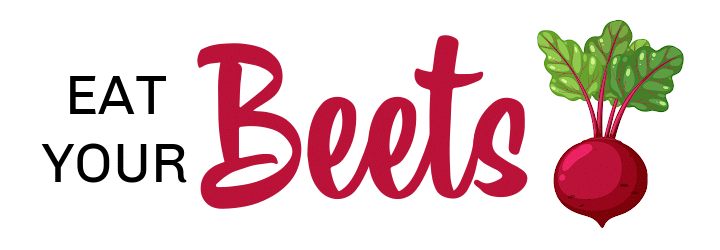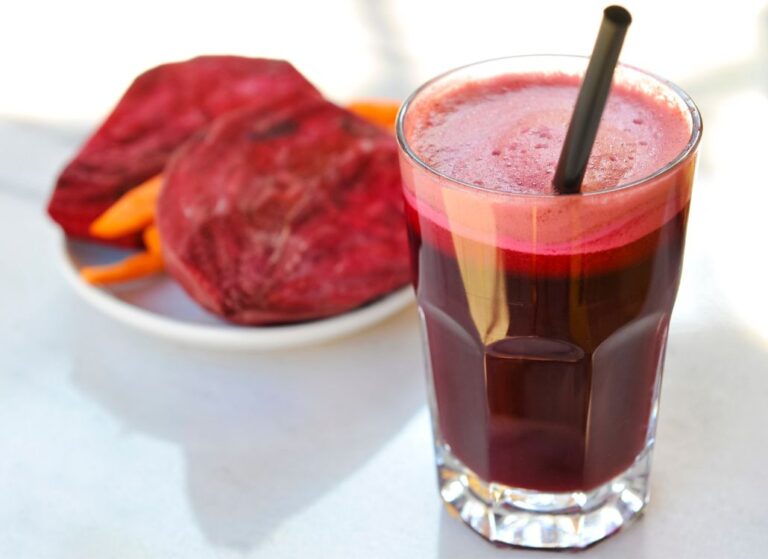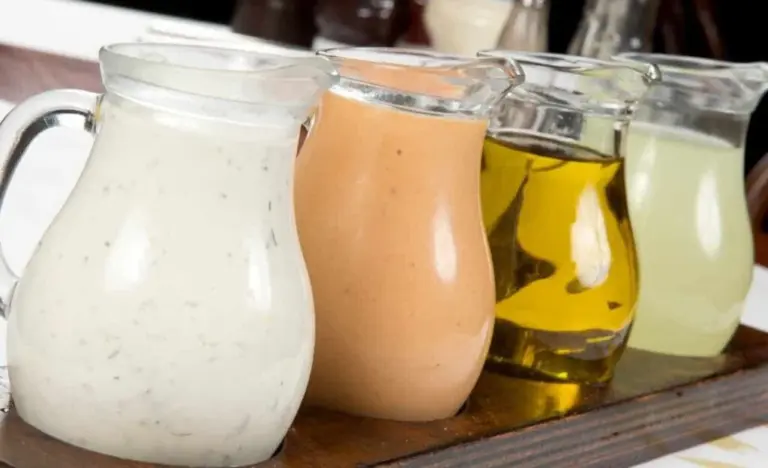Can Beetroot Leaves Be Eaten?
If you’re a health enthusiast or enjoy exploring the nutritious world of fruits and vegetables, you’ve likely wondered, “Can beetroot leaves be eaten?”.
You may have been discarding these vibrant green leaves, focusing only on the ruby-red root. This blog post will highlight the often-overlooked part of this earthy vegetable.
We will delve into the nutritional value of beetroot leaves, how they can be incorporated into your meals, and why they might become your next favorite ingredient. So, let’s uncover the hidden potential of beetroot leaves and add a splash of green to your plate.

Contents
What Are Beetroot Leaves?
Beetroot leaves, often referred to as “beet tops, turnip greens or beet greens,” are the leafy greens that sprout from beet roots, a popular type of root vegetables. These leaves are packed with minerals and vitamins that make them a nutritious addition to any diet.
Beetroot leaves are often overlooked in favor of the more commonly consumed beet roots, but they offer unique health benefits and culinary uses.
Are Beetroot Leaves Poisonous?
No, beetroot leaves are not poisonous. They are rich in vitamins A and C, iron, and calcium. However, as with any vegetable, washing them thoroughly before eating to remove any pesticides or other potential contaminants is important.
Can Beetroot Leaves Be Eaten?
So the question is, can beetroot leaves be eaten? Absolutely yes! You can eat beetroot leaves. Beet greens are a highly nutritious and underappreciated part of the beet plant.
They are sweet and mild and cook into some of the most tender greens you’ll ever eat. There are various ways to incorporate these greens into your diet.
They can be sautéed with garlic and olive oil, added to pasta, or used in an omelett. So next time you get beets, don’t neglect the greens.
What Do Beet Greens Taste Like?
Beet greens possess a distinctive earthy flavor that is reminiscent of their root counterparts, yet with an added touch of bitter-sweetness. Their taste can be likened to Swiss chard, another leafy green vegetable known for its rich, robust flavor.
When you eat beet greens, you’ll notice they have a hearty texture and a slightly peppery taste that adds depth to any dish. They’re not just a garnish or compost pile fodder; these leaves are a culinary delight in their own right.
Are Beet Leaves Edible Without Cooking?
Beet leaves, often overlooked, are not just completely edible but also incredibly nutritious. While they are often cooked to bring out their rich, earthy flavor and soften their somewhat tough texture, it’s important to know that they can also be eaten raw.
Just like other leafy green vegetables such as spinach or lettuce, raw beet greens can be tossed into salads, juiced, or even used as a garnish. Their slightly bitter taste adds a unique flavor profile to dishes.
Can You Eat Beet Stems?
Absolutely yes! beet stems, also called beet stalks, can be eaten, and they are just as nutritious as the beetroot itself. These often-discarded parts of the beet plant are rich in fiber, potassium, and vitamin C.
The leaves and stems of the beetroot can be prepared in several ways to add flavor and color to your meals. They have a taste similar to Swiss chard and can be sautéed, steamed, or even pickled.

Nutritional Benefits Of Beet Greens
A cup of cooked beet greens contains almost 60% of your daily nutritional value with little to no sugars. They are low in fat, making them an excellent choice for those looking to manage their weight or eat healthier.
Beet greens are also rich in ß-carotene, lutein, and zeaxanthin, flavonoids known for their strong antioxidant and anti-cancer activities. The presence of these antioxidants, along with vitamin C, helps support your immune system, helping it fight off viruses.
In addition to these benefits, beet greens are a natural source of sugar-regulating fiber, which can aid in maintaining healthy blood sugar levels. They are also rich in mood-boosting Vitamin B6 and iron, which improves blood health.
Moreover, beet greens are high in vitamins A, C, K, and B6. They’re also very high in iron, even more than spinach, as well as in vitamin K, B6, magnesium, and potassium. They are a great source of fiber, which aids digestion.
What To Do With Beet Greens?
Here are some tasty recipes that you can prepare with beet greens:
Sautéed Beet Greens
Sautéed beet greens are a hidden gem in the world of vegetables. The process of sautéing these greens on low-medium heat with olive oil transforms the raw, earthy taste into a delightful culinary experience.
The olive oil not only boosts the flavor but also helps in the absorption of the many nutrients found in these greens. The addition of minced garlic to the sautéed greens introduces a layer of aroma and taste that elevates the dish to new heights.
The result is a plate of delicious beet greens that can tantalize your taste buds while providing a healthy boost to your diet.

Stir-Fry Beet Greens
Stir-fry beet greens present a delightful culinary adventure, different from sautéed greens. To cook beet greens, you only need a few ingredients – beet leaves, olive oil, red pepper flakes, and freshly ground black pepper – for that extra kick.
The olive oil not only aids in the cooking process but also enhances the natural flavors of the beet leaves, while the black pepper introduces a layer of warmth and spiciness to the dish. The final result is a plate of vibrant, flavorful beet greens far from their raw, earthy beginnings.

Beet Greens Salad
Utilizing beet greens in a salad is an excellent way to make the most out of fresh beets. The key lies within the beet leaves packed with nutrients and flavor.
Rather than discarding them, consider chopping these greens into manageable, bite-sized pieces for your salad. A salad spinner can be invaluable for ensuring these chopped greens are clean and ready for dressing.
A simple sprinkle of olive oil and lemon juice enhances the natural flavors of the beet greens, adding a tangy zest that cuts through the earthiness of the greens. It creates a delicious salad that is not only pleasing to the palate but also full of health benefits.

Cooked With Other Greens
Cooking beet greens with other greens provides a delightful medley of flavors and textures that can elevate any meal. When you cook beet greens, they offer an earthy flavor that pairs well with the likes of spinach, kale, or collard greens.
The process is simple: add beet greens to your assortment of other greens and let their combined flavors meld together beautifully. Including crushed garlic in the mix introduces a pungent, spicy undertone that brings out the best in all the greens involved.
Beet Greens Pesto
Creating a pesto with delicious beet greens is an innovative way to utilize this often-overlooked vegetable. This flavorful condiment can serve as a vibrant side dish, adding a burst of color and nutrition to any meal.
The red pepper flakes incorporated into the pesto provide a subtle heat that contrasts beautifully with the earthy beet greens. So, consider turning your beet greens into a pesto next time for a unique, flavorful addition to your culinary repertoire.

Beet Green Soup
Beet green soup is a delightful way to utilize beet greens, making them hearty and satisfying. This soup showcases the earthy flavor of beet greens, enhancing their natural goodness with the addition of various spices and other vegetables.
It’s not just a delicious meal but also a nutritional powerhouse that contains vitamins and minerals. Whether served hot or cold, beet green soup can be a comforting main course or a light appetizer.
So, if you’re wondering what to do with your beet greens, turning them into a flavorful soup is a brilliant idea. Learn how to make beetroot soup, you can add beet greens also.

Beet Greens Pasta
Beet greens pasta is a delightful dish that truly celebrates the unique flavor and texture of beet greens. By incorporating them into pasta, you transform a simple noodle dish into a nutrient-dense and flavorful meal.
The beet greens pesto add a hint of earthiness to the pasta, creating a depth of flavor that’s truly remarkable. This dish showcases how versatile beet greens can be, proving they’re more than just a salad ingredient.

Roasted Beetroot Leaves
When roasting beets, don’t discard the green tops; instead, transform them into a delicious side dish. Tossed in olive oil and seasoned with pepper and salt, these beet leaves become crispy and savory when roasted.
The roasting process enhances the naturally earthy flavor of the beet greens, making them a wonderful accompaniment to any main course. So, instead of throwing those beet greens away, roast them for a tasty, nutritious, and environmentally friendly dish.
Baked Beet Greens
If you’ve ever wondered what to do with beet greens, think of them as the new kale chips. These vibrant, nutritious leaves, often discarded, can be transformed into a delicious and healthy snack.
Just like kale chips, baked beet greens are crispy, tasty, and packed full of vitamins. They’re an excellent way to utilize every part of the beet and make a guilt-free snack that’s as satisfying as it is good for you.
So next time you have some beet greens, don’t throw them away – bake them into your new favorite snack.
Sautéed Beet Greens Recipe
This recipe for Sautéed Beet Greens is a fantastic way to introduce these underrated greens into your diet. It’s simple, quick, and requires just a handful of ingredients.

Ingredients:
- 1 bunch of fresh beet greens (about 2 cups, chopped)
- 2 tablespoons of olive oil
- 2 cloves of garlic, minced
- Salt to taste
- Freshly ground black pepper, to taste
- 1 tablespoon of lemon juice (for a touch of acidity; optional)
- Red pepper flakes (optional, for heat)
Alternative Ingredients:
You can choose coconut oil as a substitute for olive oil as a dairy-free option for dietary restrictions. If you’re following a low-sodium diet, feel free to omit the salt.
Preparation Steps:
- Rinse the beet greens thoroughly under cold water to remove any dirt or grit.
- Cut off the stems and chop the leaves.
Cooking Instructions:
- Heat some of the olive oil in a skillet over low-medium heat.
- Next, add the garlic (minced) to the skillet and sauté until it becomes fragrant. It usually takes about a minute. Try not to burn the garlic, as it can turn bitter.
- Add the finely chopped beet greens to the skillet. Continue cooking, stirring frequently, until the greens become wilted and tender. It should take about 5 minutes.
- Season with dashes of black pepper and salt to taste. For a hint of heat, add red pepper flakes.
- Finish with a splash of lemon juice if desired. It adds a nice tangy flavor that balances out the earthiness of the beet greens.
Serving Suggestions:
Serve these sautéed beet greens with grilled chicken or fish as a side dish. They also make a wonderful addition to a vegetarian grain bowl. For added flavor, sprinkle crumbled feta or goat cheese on top. For a vegan option, use nutritional yeast for a cheesy taste.
Enjoy this simple, healthy, and flavorful dish!
So, Can Beetroot Leaves Be Eaten?
In conclusion, using beet greens in the kitchen is an easy and delicious way to add more colorful and nutritious foods to your diet. From salads to soups, pestos, pastas, roasting or baking – the possibilities are endless.
Whether you’re looking for a flavorful side dish or a creative new snack idea, adding beet greens into the mix could be just the thing you need.
So, don’t let beet greens go to waste – find new and exciting ways to incorporate them into your cooking for a nutritious, delicious meal!






